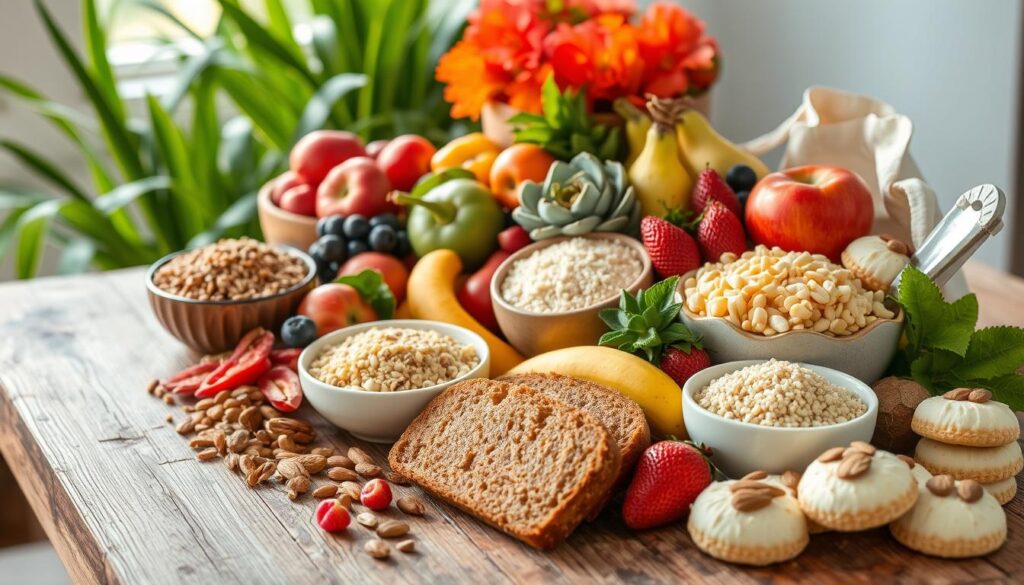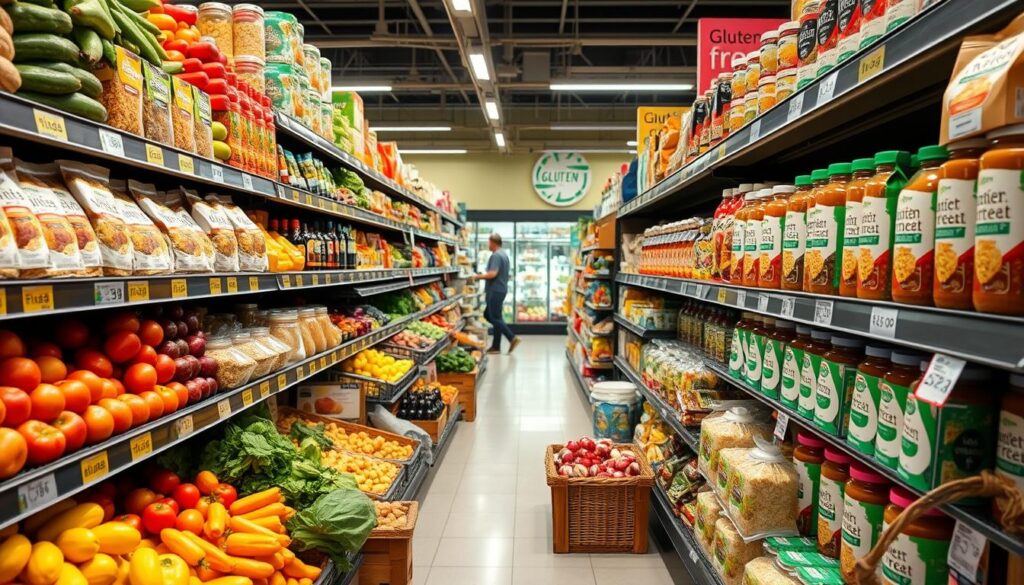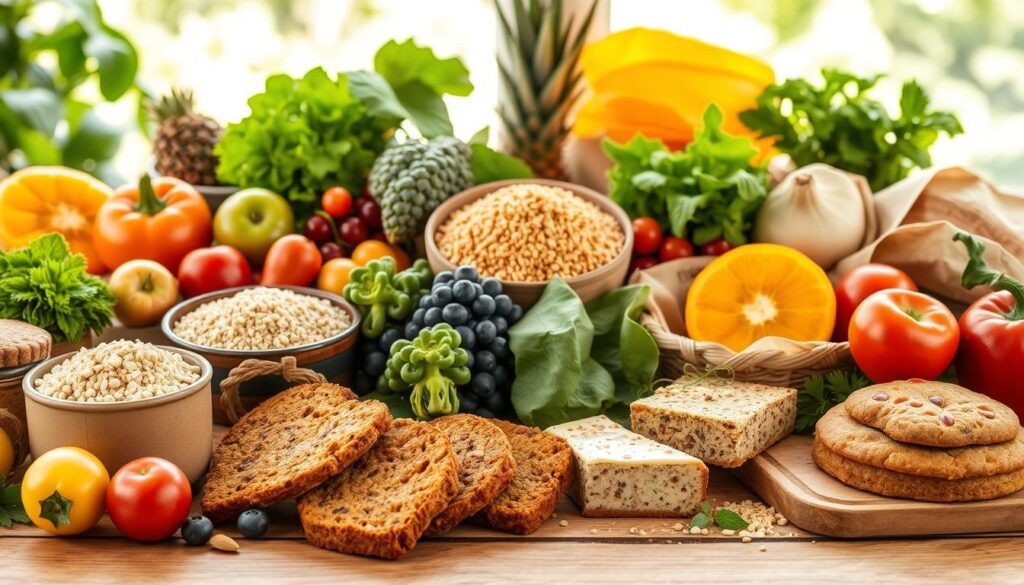If you have celiac disease, which affects about 1% of Americans, you might need to eat gluten-free. Or, if gluten makes you feel sick, a gluten-free diet could help. Up to 5% of people choose this diet for other reasons. Starting a gluten-free lifestyle is big change, but it’s key to feeling better.
A gluten-free diet means avoiding gluten in wheat, barley, and rye. It’s hard because gluten is in many foods, like bread and pasta. Getting help from a doctor is very important, especially if you have celiac disease. They can help with any nutritional problems you might face.
Key Takeaways
- Celiac disease affects about 1% of Americans, while up to 5% of the population follows a gluten-free diet by choice.
- Gluten-free diets involve avoiding wheat, barley, rye, and their derivatives, as well as being cautious of hidden gluten in processed foods.
- Consulting a healthcare professional, such as a registered dietitian, is essential when starting a gluten-free diet to ensure proper diagnosis and nutritional adequacy.
- Joining a local gluten-free support group or seeking online resources can help ease the transition to a gluten-free lifestyle.
- Certified gluten-free oats may be well-tolerated by individuals with celiac disease, but cross-contamination is a concern.
Understanding Gluten and Its Impact on Health
Gluten is a protein in wheat, barley, rye, and their products. It makes dough elastic. But, for some, gluten can harm their health. Knowing how gluten affects health is key to staying well.
What is Gluten and Where is it Found?
Gluten is a protein in grains like wheat, barley, rye, and triticale. It makes baked goods chewy and stretchy. While gluten isn’t bad for everyone, it’s a problem for those with certain health issues.
Health Conditions Requiring Gluten Avoidance
- Celiac Disease: An autoimmune disorder where the body’s immune system reacts to gluten, causing damage to the small intestine.
- Non-Celiac Gluten Sensitivity (NCGS): A condition where individuals experience gastrointestinal symptoms, such as bloating, diarrhea, and headaches, after consuming gluten, despite not having celiac disease.
- Wheat Allergy: An allergic reaction specifically to wheat, which may or may not be related to the gluten content.
- Gluten Ataxia: A rare neurological autoimmune disorder where the body attacks parts of the brain in response to gluten consumption.
Signs and Symptoms of Gluten Sensitivity
People with gluten-related disorders may feel tired, have anemia, or depression. Celiac disease can damage the intestines and lead to nutrient deficiencies. Getting a proper diagnosis is important before starting a gluten-free diet.
“Changing to a gluten-free diet may increase the risk of obesity and metabolic syndrome for patients with celiac disease, potentially due to the low nutritional quality of processed gluten-free foods containing refined sugars and saturated fats.”
Understanding gluten’s role in health is vital for good digestion and well-being. Recognizing gluten sensitivity symptoms helps address health issues and make better food choices.
Benefits and Challenges of a gluten free diet
Starting a gluten-free lifestyle can really help those with gluten issues. It means saying no to wheat, barley, rye, and other gluten grains. Many people feel better without these, as they avoid stomach problems, tiredness, and brain fog.
Going gluten-free means trying new nutritious recipes with grain alternatives. Foods from Mexico and India are often gluten-free. This lets you try new things and find healthy foods that taste great.
But, there are tough parts to a gluten-free diet. People with celiac disease might not get enough nutrients if they don’t plan their meals right. They should talk to a dietitian for help. Also, some gluten-free foods can have more calories, sugar, and bad stuff, which can make you gain weight or cause health issues.
It can also be hard to eat out or go to parties because of gluten. You have to watch out for hidden gluten and make sure food isn’t mixed with gluten. Reading labels and talking to restaurant staff is key to eating safely and enjoying yourself.
Even with the hard parts, a gluten-free diet can really help those with gluten issues. Eating the right foods and getting help from experts can make you feel better and live better.

“A gluten-free diet can be a life-changing experience for those with celiac disease or gluten sensitivity. With the right approach and support, it can lead to improved digestion, increased energy, and an overall enhancement of your quality of life.”
Foods to Avoid on a Gluten-Free Diet
If you have a wheat allergy, food intolerances, or digestive health concerns, you need to follow a gluten-free diet. Gluten is a protein in wheat, barley, and rye. It can make people with celiac disease or gluten sensitivity feel sick.
To stay healthy, you must find and remove gluten from your food.
Common Sources of Hidden Gluten
Gluten can hide in foods you don’t expect. It’s important to read food labels carefully. Avoid bread, pasta, and baked goods, but also watch for gluten in sauces, condiments, processed meats, and some drinks.
Soy sauce, salad dressings, and some beers have gluten. Always check the ingredients.
Cross-Contamination Risks
Shared cooking spaces and utensils can spread gluten, even if foods are gluten-free. Be careful when eating out or in kitchens where gluten foods are made. Try to avoid getting gluten on you by accident.
Reading Food Labels Effectively
When you’re shopping for gluten-free foods, look for the “gluten-free” label. Don’t buy products with wheat, barley, rye, or their parts in them. Oats are gluten-free but might get gluten on them. Choose certified gluten-free oats.

By carefully reading labels, finding hidden gluten, and avoiding cross-contamination, you can follow a gluten-free diet well. This helps keep your wheat allergy, food intolerance, and digestive health safe.
Safe and Nutritious Gluten-Free Foods
Starting a gluten-free diet doesn’t mean you have to give up taste or nutrition. There are many healthy, gluten-free foods to make tasty meals. Fresh fruits, veggies, meats, fish, dairy, legumes, nuts, and seeds are all gluten-free and full of good stuff.
For grains and flours, try rice, corn, quinoa, millet, buckwheat, and nut flours. These can be used in many recipes, like breads, pastas, baked goods, and cereals. Eating whole, unprocessed foods makes your gluten-free diet healthy and filling.
Not all gluten-free foods are the same. Some are convenient but not always the best choice. Always check labels for good nutrition. Talk to a dietitian to make a balanced gluten-free meal plan that fits you. Try new foods and recipes to make your diet exciting and varied.


A Life-Changing Experience with This Weight Loss Supplement (Nagano Tonic)
I’ve always struggled with finding a weight loss solution that actually works for me. Like many, I’ve tried numerous diets, exercise routines, and supplements over the years—some worked for a short time, but nothing ever gave me long-term results. That was until I decided to try the weight loss supplement I found : Link to the Supplement.
From the moment I started using it, I noticed a difference. Not only did I feel more energized, but my cravings also became more manageable. The best part? I started seeing results much quicker than I anticipated! Over the course of just a few weeks, I noticed a significant reduction in belly fat and overall weight loss that I hadn’t been able to achieve before.
What makes this supplement stand out from all the others I’ve tried is how it supports me in my daily routine without any jitters or energy crashes. I’m able to stay focused and motivated, which has made it easier to stay on track with my diet and exercise plan.
This product truly exceeded my expectations, and I feel more confident and healthier than ever before. If you’re struggling with your weight loss journey like I was, I highly recommend giving this supplement a try. It’s been a game-changer for me, and I’m sure it can work wonders for you too!
Contant Them on email .. tonicnagano50@gmail.com
I’ve tried so many weight loss products over the years, but nothing worked like this supplement! Since I started using it, I’ve noticed a big difference in my energy levels and appetite control. In just a few weeks, I’ve lost weight and feel so much better. It’s been easy to stick with, and the results speak for themselves. Highly recommend this to anyone looking to make a real change!
wasn’t sure what to expect, but this weight loss supplement has really impressed me! After just a few weeks of use, I’ve already dropped a few pounds and feel more motivated to stay active. It’s helped curb my cravings and boosted my energy throughout the day. I’m excited to keep going and see even better results. Definitely worth trying!
Reach them on tonicnagano50@gmail.com
I was skeptical at first, but this supplement has truly made a difference in my weight loss journey. I’ve lost weight without feeling deprived or sluggish. My cravings are under control, and I feel more confident in my body. It’s easy to incorporate into my daily routine, and the results speak for themselves. I’m so glad I gave it a try!
Thanks David, i do use the link to make my purchase. you can get too here http://surl.li/iasppy
This Nagano Tonic has been amazing! In just a few weeks, I’ve lost weight, feel more energized, and my cravings are under control. Highly recommend it!
Thats the link to purchase http://surl.li/iasppy